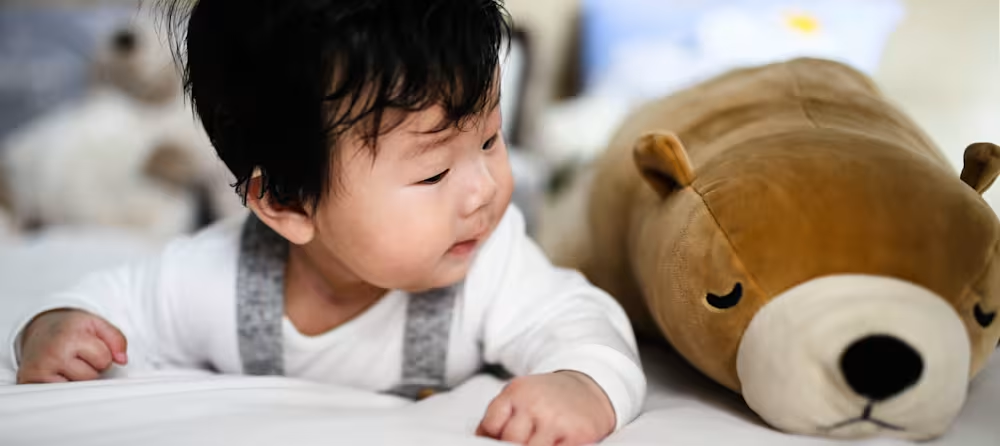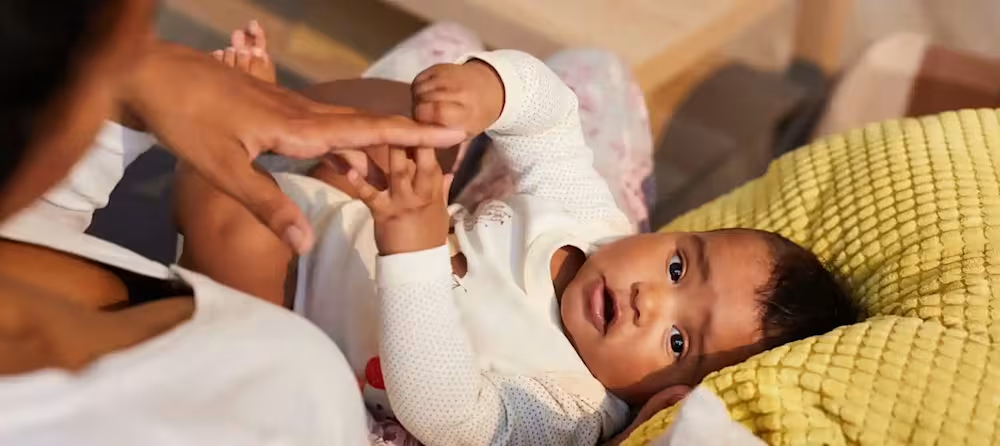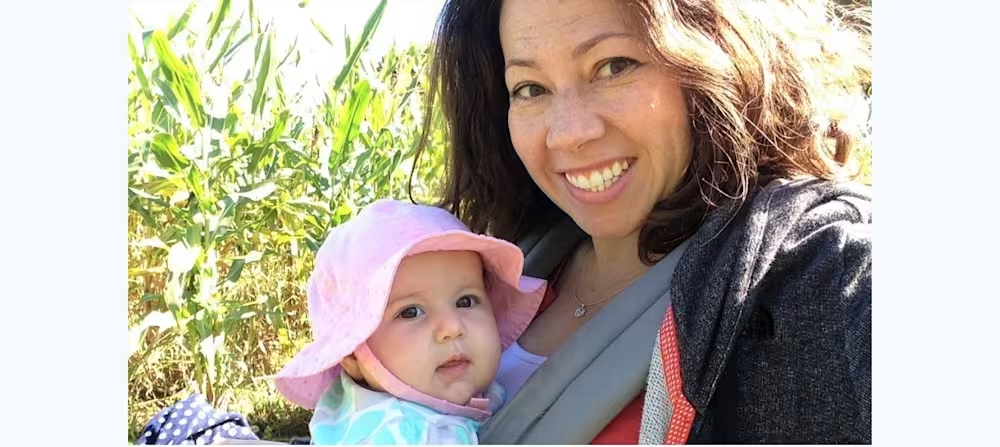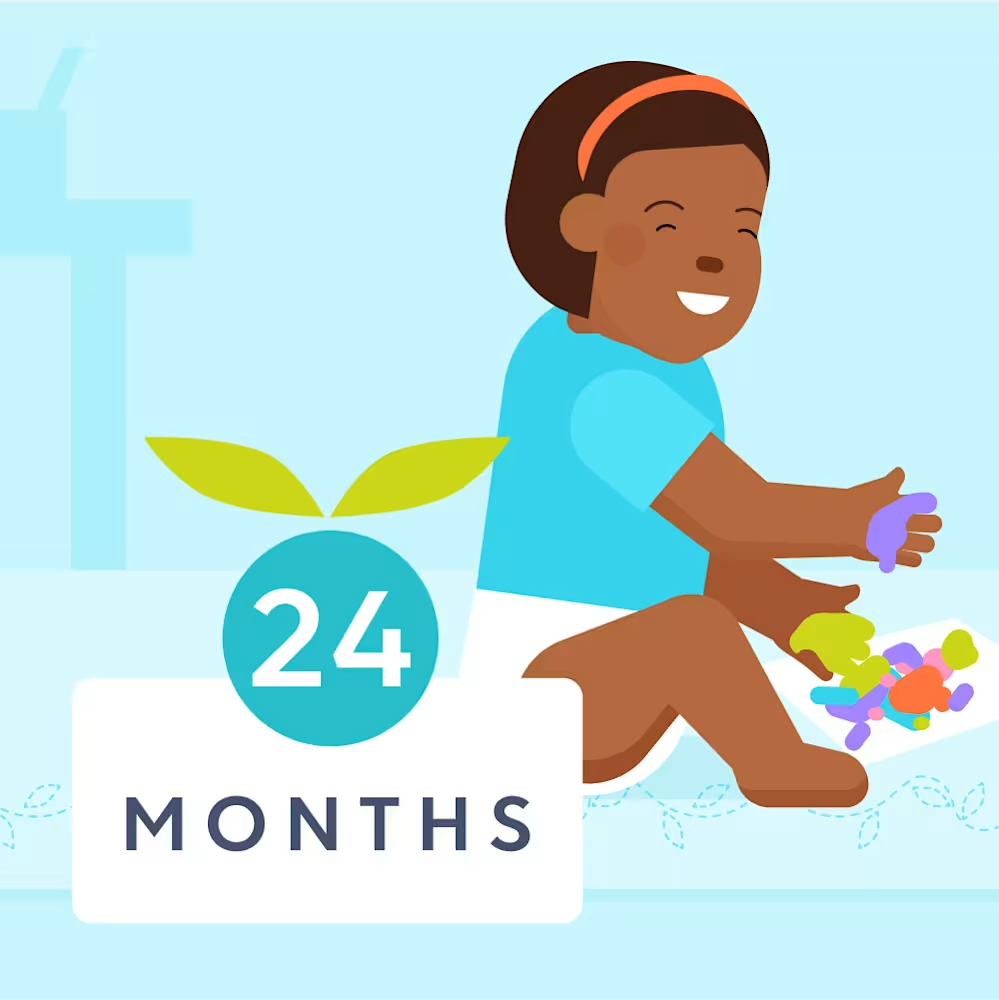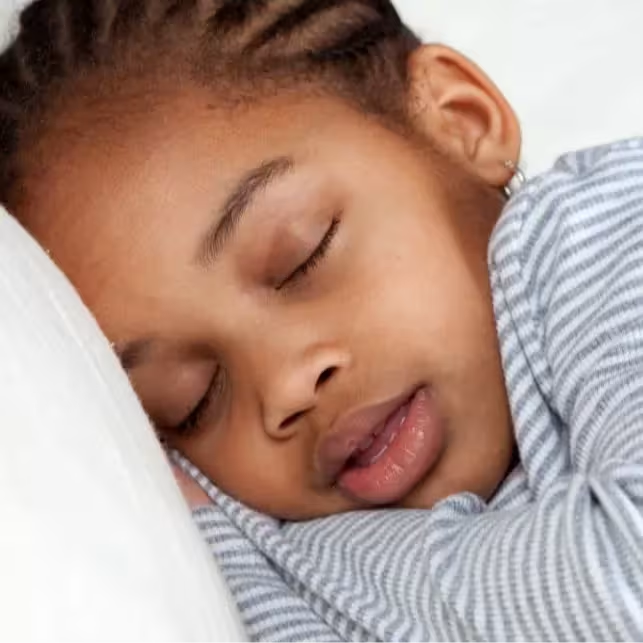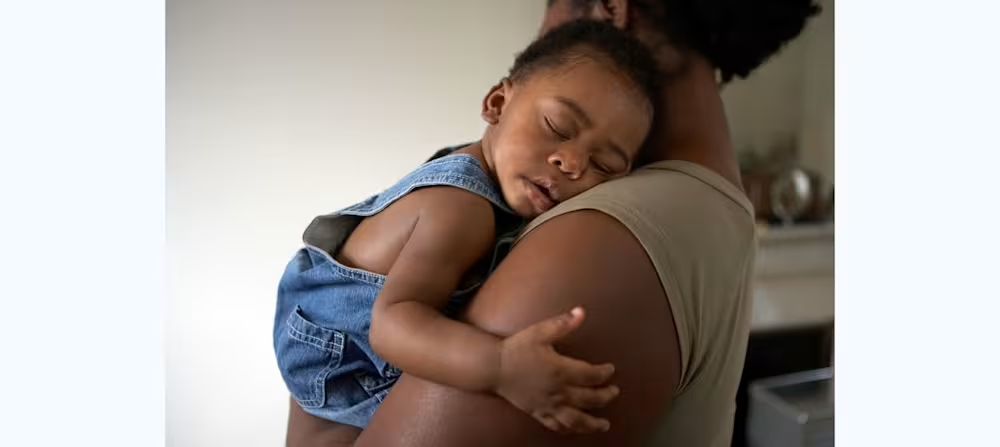2 year old sleep regression: What causes it and what to do
Updated Nov 24, 2025

Is your toddler suddenly behaving as if sleep is their worst enemy? You’re not alone. Like a teetering tower of wooden blocks, sleep challenges at 2 can knock over solid routines and derail sleep, leaving everyone feeling exhausted.
In this article, we’ll walk you through the so-called “2 year old sleep regression,” reassure you that this patch of rocky sleep is normal, and give you tools for addressing toddler sleep challenges.
Have questions about toddler sleep challenges?
Table of Contents
What’s behind the 2 year regression: Reasons and signs
Parenting a 2 year old is often both incredible and exhausting. Kids at this age are full of curiosity, surprises, and rapid development. But with all this growth and development comes new challenges, especially in the sleep department. Here’s a look at the most common factors that can shake up sleep at this age:
Limit testing and independence-seeking behaviors
A change in sleep needs
Transition to toddler bed too early
Milestones, like potty training
Big changes at home
Separation anxiety
Nighttime fears
We'll explain these contributing factors further below:
Limit testing and independence-seeking behaviors
Toddlers are supposed to explore their world and test boundaries! While these behaviors are integral to their development, it can be frustrating when they interfere with sleep. Why lay down and close your eyes when there are toys to be played with and mischief to be made?
In their search for autonomy, kiddos might try antics like removing their diaper at bedtime, refusing to get PJs on, or throwing all of their belongings out of the crib.
A change in sleep needs
Children at 2 can usually comfortably stay awake for longer periods now. They need to be awake longer in order to be sufficiently tired before bed. So when they’re put to bed too early, [] this can result in long, drawn-out battles at bedtime.
It also means that toddlers are capable of long, drawn-out nap strikes. When naps are short or skipped, especially for days in a row, kiddos often become cranky, conk out on the couch in the late afternoon (which leads to a tricky bedtime), and/or wake frequently overnight due to overtiredness.
Transition to toddler bed too early
Famillies may transition kiddos at this age, especially if a new sibling is on the way. However, since children haven’t always developed the impulse control required to stay in bed all night, this can create a situation where they’re suddenly popping out of bed ALL. NIGHT. LONG.
Milestones, like potty training
New motor skills and developmental milestones like toilet training are so exciting. However, they may lead to new sleep challenges. When potty training, it’s common for toddlers to repeatedly request to use the potty both during and after the bedtime routine, resulting in a late bedtime and an overtired child.
Toddlers may also need (or want) to use the bathroom or early in the morning. These sleep disruptions can lead to a shortened night’s sleep and overtiredness, especially if your child has trouble falling back to sleep quickly. Hello, 5 A.M. wake-ups, but bye-bye diapers! is a frustrating but normal part of your toddler’s development as they adjust to big changes to their routine and independence.
Big changes at home
LIfe events like starting a new school or daycare and welcoming a sibling are a big deal to kiddos! These changes can shift routines, impact parenting dynamics, and even trigger emotional or sleep challenges as your child adjusts to their new normal.
Separation anxiety
It’s common for toddlers this age to go through another wave of, making it harder for them to separate from caregivers [] at sleep times. Children who’ve been falling asleep on their own may suddenly want their parents to stay with them at bedtime until they fall asleep. This can lead to a sleep onset association that disrupts their sleep (and yours!) throughout the night.
Nighttime fears
As children grow, their imaginations continue to expand, which can lead to .
Your toddler may also want you to stay with them at bedtime because they’re feeling scared. Similarly, when they wake at night, they may be more likely to call out for your comfort.
How long does the 2 year old sleep regression last?
When does it start?
Sleep regressions don’t have definitive start and end dates. Sudden changes in your child’s sleep patterns can happen at any time and there’s no magic date on the calendar to predict them. Plus, some kids breeze through their second year with little to no changes to their sleep, while others may experience more ups and downs. This is normal and expected — every child is different.
When does it end?
A sleep regression at 2 won't have a definitive end date either. The duration of a sleep regression depends on the factors that are contributing to poor sleep and whether new sleep associations are created during this time.
Some developmental regressions can last a week or two and then resolve on their own. Other times, a toddler may get stuck in a new sleep habit which impacts sleep for much longer.
My 2 year old won’t nap. Does the 2 year old regression affect naps?
Yes, it’s common for children to fight daytime sleep around the time they turn 2. This is typically a temporary phase so we recommend continuing to offer a daily nap. Even if they don’t sleep, some quiet time will allow them to slow down and rest. Most children aren’t ready to completely until closer to 3 - 5 years old.
7 sleep tips for 2 year olds to handle sleep regressions
Tip | Notes |
Offer simple choices and set boundaries | Giving toddlers clear, simple choices fosters independence while setting firm limits keeps bedtime routines predictable and reduces stall tactics. |
Implement an age-appropriate schedule | A well-timed sleep schedule prevents overtiredness and bedtime battles. Most 2 year olds still need a daily nap and about 5.5 – 6 hours of awake time before bed. |
Keep the crib | Staying in the crib until around age 3 supports better sleep and reduces nighttime wandering. Use a sleep sack to prevent climbing if needed. |
Include common requests in your bedtime routine | Build typical “last requests” like one final potty trip, sip of water, or hug into the routine, then be consistent when it’s time for lights out. |
Move bedtime earlier when naps are skipped | On no-nap days, shift bedtime 20 – 30 minutes earlier to avoid overtiredness and night wakings. |
Build feelings of security | Ease separation fears by offering daily one-on-one time, using a warm-hued night light, or introducing a comfort item to help your toddler feel safe at night. |
Heap on the positive reinforcement | Praise specific bedtime behaviors and use small rewards or visual cues like sticker charts to encourage continued success and confidence at night. |
Tip #1: Offer simple choices and set boundaries
Toddlers want to call the shots and feel in control as they navigate new feelings and opinions, even if they can’t carry out all their big ideas quite yet []. But, you can help limit power struggles around sleep by fostering their independence and confidence at bedtime.
An easy way to do this is to give them concrete choices, such as, “Would you like to wear the yellow pajamas or the green pajamas?” or, “Would you like to brush your teeth or read a book first?”
Since stalling at bedtime is common in this age group, it’s more important to set limits and stick with them. Maintaining a consistent routine with a definitive end (bed!) helps them understand what comes next and cuts down on their use of stall tactics.
Try something straightforward like “We’re going to change into your pajamas, read two books, and then go to sleep.” When parents occasionally give in to requests for “one more book” or “one more snack,” this often encourages the behavior to continue.
Tip #2: Implement an age-appropriate schedule
When you have a child already looking to test boundaries, mistimed sleep can compound challenges around bedtime.
For example, when it comes to a , most kids need around 5.5 - 6 hours of awake time in order to be tired enough to sleep. This means that if your child usually gets up from their nap around 3:00 PM, setting bedtime at 9:00 PM may reduce resistance around going to bed. For families aiming for an earlier bedtime, shifting the nap (or even the morning wake-up time) earlier can help.
The need for longer wake windows (and skipped or short naps when wake windows are too short) can trick parents into thinking their 2 year old is ready to give up napping. However, 2 year olds are rarely ready to drop the nap entirely.
While frustrating, nap strikes are common! They generally last a couple of weeks so we recommend continuing to regularly offer a nap (around 5.5 hours after waking) instead of ditching it altogether.
Children who drop the last nap too early often start to wake more at night or too early for the day and don’t get enough sleep overall. Most kiddos will continue to sleep during the day (at least somewhat regularly) until around age 3.
Tip #3: Keep the crib
If possible, we recommend keeping children in their crib until at least 3 years of age. The transition from crib to bed tends to go smoother around then, when self-control skills are further developed. When children aren’t quite developmentally ready for this switch, it can lead to middle-of-the-night visits and bedtime refusal.
Note that the American Academy of Pediatrics recommends transitioning out of an enclosed crib when the child reaches 35 inches [] or when the side rail is about nipple level.
If climbing out of the crib is a concern, consider using a) at bedtime. This will make it harder for a toddler to hoist their leg over the side of the crib.
Be sure to have the mattress at the lowest setting and remove any objects in the crib that could be used to step on and reach further over the crib.
Tip #4: Include common requests in your bedtime routine
If your toddler is toilet training and bedtime is typically delayed by trips to the bathroom, make sure to build potty time into the routine. After your usual bedtime routine, you can offer “one last” trip to the bathroom.
Similarly, you can end your routine with “one last” hug or sip of water — whatever your child likes to request at bedtime. It’s important to be firm and consistent when you explain something is the “last time” for the night.
Tip #5: Move bedtime earlier when naps are skipped
Having a consistent daily schedule helps regulate your toddler’s internal clock and makes it easier for them to fall asleep and stay asleep.
Despite your best efforts, chances are your toddler will skip their nap from time to time. When this happens, it can be helpful to move bedtime slightly earlier to limit overtiredness. When too tired, you may see 2 year olds waking up at night and very early in the morning.
So how much earlier should you move bedtime? It’s all about finding the right balance — moving it too early can lead to an early waking cycle and throw off your child’s circadian rhythm. Sometimes offering bedtime 20 - 30 minutes earlier is enough to help avoid overtiredness.
However, if naps are skipped repeatedly, your toddler may struggle to even make it through dinner. In those cases, we recommend aiming for a sleep time around 12 - 12.5 hours before your kiddo’s typical wake time. So if your child normally wakes around 7:00 AM, try targeting a 6:30/7:00 PM bedtime on days they skip their nap.
Tip #6: Build feelings of security
If your toddler is showing signs of and/or , you can take steps to increase their feelings of security as much as possible. Many parents find it helps to designate one-on-one time with their child each day, even if it’s just 10 - 15 minutes of your undivided attention.
Some toddlers feel safer with night lights in their room or if their door is left open. Since blue lights can suppress melatonin production [], look for a night light that uses red light or another soft hue. You can also consider introducing a new special stuffed animal friend to help your child feel safe and secure at bedtime.
Tip #7: Heap on the positive reinforcement
When bedtime or night sleep go smoothly, be sure to let them know what a great job they did with specific praise. This will encourage more of the behavior you want to see. You might say, “I love how you just changed into your pajamas so quickly!” or, “You slept the whole night without calling for mommy. We both got the sleep we needed. I’m so proud of you!”
These accomplishments can be paired with small prizes for extra encouragement. For example, a toddler who stays quietly in bed all night may or a special time or activity with a parent.
Many families also find it helpful to use external visual cues, like a toddler clock and/or sticker chart, to help overcome more challenging sleep issues such as early waking.
How much sleep does a 2 year old need?
We recommend that get at least 11 - 14 hours of total sleep per day. This usually breaks down to around 10 - 12 hours of nighttime sleep and 1.5 - 2 hours of daytime sleep. However, every child is different and has unique sleep needs. Keep in mind these are general guidelines. Also consider your child's mood and energy levels to gauge if they’re getting enough rest.
Can you sleep train during a sleep regression?
Sleep training can be an option for a during a sleep regression. Various methods can help your child learn independent sleep skills that lead to better sleep for them — and you.
However, keep in mind that toddlers at this age can be more resistant to change, especially when it comes to naps. It’s not uncommon for older toddlers to start skipping naps altogether during this process, even when they still need the daytime rest.
Can I let my 24 month old cry it out during a sleep regression?
"” (CIO) is one sleep training option to consider for a 2 year old. Parents sometimes prefer to go this route if their child becomes more upset with the check-ins used in other sleep training methods (like Ferber method). At this age, some toddlers may cry intensely at first as they protest the change, especially if they're used to falling asleep with help. It’s important to make sure the sleep environment is safe — remove pillows, blankets, or toys that your child could use to climb or step on while trying to get out of the crib. Before starting CIO, ensure your child is fed, dry, and safe before putting them down. We also recommend using a video baby monitor. There are other types of sleep training, like fading, that can be useful for families who prefer to make gradual changes. These techniques can take longer — a couple of weeks or more — but often involve fewer tears upfront. There’s not a one-size-fits-all approach to sleep training methods so pick the one that feels right to you and adjust as needed.
What are self-care tips for tired parents?
Take a mini break: At this age, your child likely doesn’t need the constant supervision that they did even a few months ago. While they’re safely engaged with toys or a TV show, consider taking a 10-minute “break” to finish your coffee, text with a friend, or just sit and do nothing if that’s preferable. Working in these little moments throughout your week can feel like a big victory.
Have a dance party: Toddlers typically love music and doing special things with their parents. A spontaneous dance party is a great way to burn off energy, share a laugh, and reconnect. It helps your toddler get their wiggles out and can give you a much-needed mood boost. Plus, it makes for some unforgettable (and adorable) memories.
Remember it’s a phase: The messes, meltdowns, and sleep challenges are all developmentally normal and often temporary. Reminding yourself that this stage won’t last forever can help you gain some perspective, especially on days when you’re extra exhausted.
Should I let my 24 month old sleep in my bed during a regression?
The American Academy of Pediatrics (AAP) advises against bedsharing during the first year of your child’s life to reduce the risk of SIDS []. After 12 months, the risk of SIDS drops significantly. The AAP still doesn’t formally endorse bedsharing, however, the guidance becomes less specific for children over 1.
Many families choose to bedshare at this age, especially during tough sleep stretches. If you decide to bring your toddler into bed, it’s still important to prioritize safety. Be mindful of potential risks such as falls, suffocation, and entrapment. To help create a safer sleep environment, consider the following best practices:
Use a firm mattress
Keep pillows and heavy blankets away from your child
Avoid sharing the bed with anyone under the influence of substances that affect alertness, like alcohol and certain medications
When to talk to a doctor
Bouts of poor sleep are very common, even in the toddler years. Usually, these phases are normal and not cause for concern. However, if your child’s sleep habits feel concerning or you’re even unsure, check in with your child’s doctor for peace of mind.
Here are some instances where you might consider checking in with your child’s doctor:
Eating or weight gain concerns: Consistently skipping meals, not gaining weight as expected (though growth slows down in your baby’s second year)
Signs of pain: Inconsolable, complaints of pain
Unusual symptoms: Vomiting, a lingering cough, fever, rash etc.
Unusual sleepiness: Overly drowsy, hard to wake
Other concerns: If something feels off, check in — it’s often better to err on the side of caution
Takeaway
Typical sleep regression signs: skipping naps, resisting bedtime, sudden night waking, and waking up too early in the morning.
Why is sleep hard?: Children may experience the so-called “2 year sleep regression” due to contributing factors like testing boundaries, changes in sleep needs, transitioning out of a crib too early, big changes at home (like a new sibling or move), and milestones like potty training. Other things, like nighttime fears, can also cause a temporary disruption in typical sleep patterns.
Navigating sleep regressions: Some ways you can help your little one during a sleep regression include offering simple choices and setting healthy boundaries. Other things that may help during times of difficult sleep include building common requests (like a drink of water) into your child's bedtime routine and lots of positive reinforcement around behaviors you do want to see.
Follow an age-appropriate sleep schedule: This can help prevent overtiredness and encourage your child to nap even if they've been fighting daytime sleep. If a nap is skipped, move bedtime earlier.
2 year old sleep regression FAQ
Share article:
Note: The content on this site is for informational purposes only and should not replace medical advice from your doctor, pediatrician, or medical professional. If you have questions or concerns, you should contact a medical professional.
8 Sources
Table of Contents
Share article:
